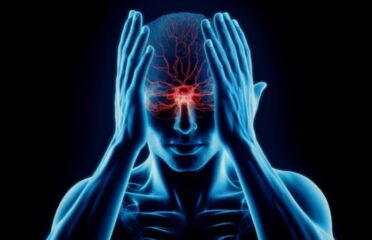Binswanger's Disease
Overview

Binswanger's disease, also known as subcortical vascular dementia, is a type of dementia that affects the brain's white matter.
The condition involves microscopic damage to small blood vessels and nerve fibers, resulting in the death of brain tissue.
The damage is caused by the thickening and narrowing of arteries due to atherosclerosis, which decreases blood supply to the subcortical areas of the brain.
As a result, the brain's white matter, which consists of nerve fibers surrounded by myelin, a protective insulation made of fats and other materials, is affected.
This condition can lead to symptoms such as memory loss, difficulty speaking, and trouble with movement
Symptoms
• Binswanger disease is a type of vascular dementia resulting from the blockage of blood vessels that supply deep brain structures, often due to conditions like arteriosclerosis and thromboembolism.
• Risk factors for Binswanger disease include hypertension, smoking, high cholesterol, heart disease, and diabetes mellitus, all of which contribute to vascular health issues.
• In some instances, hereditary conditions like CADASIL can also lead to Binswanger disease, although this is relatively rare.
• Rather than a specific disease, Binswanger disease is considered a clinical syndrome with diverse underlying causes.
• Reduced blood flow in brain tissue due to vascular issues can trigger secondary inflammation, which may require appropriate treatment.
• Management strategies for Binswanger disease focus on addressing underlying vascular risk factors and alleviating symptoms to improve quality of life.
Causes & Risks
• Binswanger disease is a type of vascular dementia stemming from blocked blood vessels supplying deep brain structures.
• Causes include arteriosclerosis, thromboembolism, and other related conditions.
• Risk factors encompass hypertension, smoking, high cholesterol, heart disease, and diabetes.
• Rare hereditary conditions like CADASIL can also contribute to Binswanger disease.
• It's considered a clinical syndrome of vascular dementia with diverse underlying causes.
• Reduced brain blood flow can trigger secondary inflammation, sometimes necessitating treatment.
Test & Diagnosis
• Binswanger's disease diagnosis relies on a thorough clinical assessment.
• Evaluation involves patient history, physical examination, and imaging tests.
• Magnetic resonance imaging (MRI) or computerized tomography (CT) scans are common.
• These scans detect nerve fiber degeneration and white matter changes.
• Additionally, they reveal multiple small strokes in deep brain areas.
• Comprehensive evaluation aids in confirming Binswanger's disease diagnosis.
Treatment
• Binswanger disease can lead to irreversible brain damage but can be managed.
• Lowering stroke risk and slowing disease progression is possible.
• Treatments include anti-hypertensive and antiplatelet drugs, statins, and smoking cessation.
• Diabetes control is crucial, along with medications like cholinesterase inhibitors and levodopa.
• Symptomatic relief involves antidepressants, good sleep habits, and regular exercise.
• Therapies like speech, occupational, and physical therapy can enhance quality of life.
Living With
Binswanger's disease is a type of vascular dementia characterized by progressive damage to small blood vessels in the brain, leading to cognitive decline.
It can cause difficulties with memory, thinking, problem-solving, and decision-making.
Individuals with this condition may also experience changes in behavior and personality, physical symptoms such as gait disturbances, and an increased risk of strokes.
As the condition advances, the need for assistance with daily tasks may increase, impacting an individual's ability to perform daily activities independently.
Providing care for someone with Binswanger's disease can be demanding physically, emotionally, and financially for caregivers due to the progressive nature of the condition and the need for ongoing support.
While there is no cure for Binswanger's disease, management involves addressing symptoms, providing support for the individual's cognitive and physical needs, and implementing strategies to enhance quality of life. Both individuals with Binswanger's disease and their caregivers may experience emotional distress, stress, and feelings of frustration or sadness due to the challenges associated with the condition.
Complications
• Binswanger's disease presents challenges, impacting quality of life.
• Cognitive decline is a primary complication, affecting memory and problem-solving.
• Behavioral changes like depression and irritability are common.
• Physical symptoms include gait disturbances and muscle weakness.
• Increased risk of strokes further exacerbates neurological symptoms.
• As the disease progresses, individuals may require more assistance with daily tasks.

The Content is not intended to be a substitute for professional medical advice, diagnosis, or treatment. Always seek the advice of your physician or other qualified health provider with any questions you may have regarding a medical condition.
Know more about
Our Healthcare Planner
Personal Health Planner at BNC is a support staff who listens to your concerns and connects you with a Neuro Care provider. They prioritize your needs and create a trusting relationship between you and the provider.
Three fundamental values we can assure you:
1. Personalized Healthcare.
2. Most advanced robotic therapies
3. Transparent pricing





